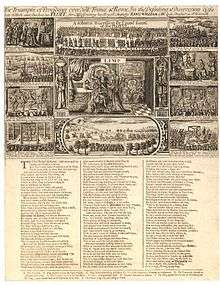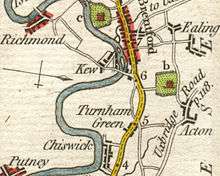Jacobite assassination plot 1696
The Jacobite assassination plot 1696 was an unsuccessful attempt led by George Barclay to ambush and kill William III of England in early 1696.

Background
One of a series of plots by Jacobites to reverse the Glorious Revolution of 1688–9, the plot of 1696 had been preceded by the "Ailesbury plot" of 1691–2. Strictly the "Fenwick plot" of 1695 is distinct from the assassination plot of 1696. The successor was the proposed French invasion of Scotland of 1708.[1]
Robert Charnock had served under John Parker in the Jacobite cavalry at the Battle of the Boyne in 1690. In 1694 he was put in command of forces raised in the London area by Parker, for a potential Jacobite rising against William and Mary. Parker also drew in George Porter and Sir William Parkyns. He left the country in the middle of 1694. By then Charnock was discussing a plan to kidnap William III and take him to France. Mixed messages from James II confused the issue, and nothing had been done by April 1695, when William left the country.[2]
Sir John Fenwick, 3rd Baronet was one of the inner circle advising James on English affairs, and was hawkish. The death of Queen Mary at the end of 1694 revived their interest in direct action in England, and finance from France arrived by April 1695. Fenwick, however, was opposed to the schemes proposed by Charnock and his group. Meeting in May with Sir John Friend and others, he sent Charnock to France to move a plan for a massive invasion, instead. In June Fenwick was involved in Jacobite rioting and was arrested. Sir George Barclay was sent to act as his deputy in commanding forces supposed to co-ordinate with an invasion force under the Duke of Berwick. Barclay assessed the plan as hopeless, shunned Fenwick, and went back to the original idea of "kidnapping" William, certainly a euphemism for an assassination.[3]
Plan

The plot was based on William III's habitual movements, on returning from hunting. On the south bank of the River Thames, at Kew, he would take a ferry that would bring him to the north bank, on a lane that ran from Turnham Green to Brentford (at this period these places were not built up, and lay west of the London conurbation).[4] Barclay's plan depended on surprising William in his coach, and his armed escort. It was intended to use three parties of armed men, one to capture the king, and the others to deal with his guards.[5] A point was chosen on the lane which was narrow enough so that the royal coach and six horses would not be able to manoeuvre.[6]
The plot was prepared and its armed men were ready to act on 15 February and 22 February 1696. One party was under the command of Ambrose Rookwood.[5]
Detection of the plot
William Trumbull, who was Secretary of State for the Northern Department at the time, heard about the plotting from August 1695. He gathered intelligence on it through informers, and led the early investigation, which later was handed over to James Vernon.[7] There was no shortage of rumour, with the information from Thomas Prendergast proving decisive: he had been approached by George Porter on 13 February, and then went to William Bentinck, 1st Earl of Portland to reveal the conspiracy. In a second interview he gave the king details of the conspirators, a group numbering around 40 in all.[8]
The ramifications of the plot proved more troublesome to Vernon. Fenwick defended himself actively by trying to implicate Lord Godolphin, the Duke of Shrewsbury, the Earl of Marlborough, and the Earl of Orford. These charges led into the heart of the Junto, and Shrewsbury was Vernon's immediate superior.[9] To add to the awkward position, this group of Whigs had in fact been in correspondence with James II at St Germain.[10]
Aftermath
The attempt did not take place on either day when the plotters were in position, and on 23 February a proclamation was made against them.[5] Early arrests were made of Jacobites with connections to Fenwick, but not involved in the assassination plot, such as James Grahme on 3 March, Bevil Higgons and Thomas Higgons. They were later released.[11][12][12][13] Thomas Bruce, 2nd Earl of Ailesbury, a Jacobite conspirator but not directly involved, was imprisoned in the Tower of London on 21 March, where he was kept to February 1697.[14] Viscount Montgomery was named in a proclamation, went into hiding, and gave himself up on 15 December. He was kept in Newgate Prison for about seven months.[15]
A long sequence of trials related to the plot began in March.[16] A point of law brought in by the Treason Act 1695 made the date of arrest crucial in determining whether those accused of treason could have defense counsel. Sir John Holt enforced the letter of the law, meaning that Friend, Parkyns and Charnock could have no counsel.[17] Friend and Parkyns were attended at their execution by three clergymen, Jeremy Collier, Shadrach Cook and William Snatt who were nonjurors. Their actions caused a furore, and Cook and Snatt were brought to trial. Collier went into hiding and was outlawed. After guilty verdicts Cook and Snatt were released, and the matter in time blew over.[18][19]
Rookwood and others, who had counsel, were executed in April.[5] Eventually there were nine executions of Jacobite activists.[20] Sir John Fenwick was convicted on a bill of attainder, and was executed on 28 January 1697.[21] Six other accused plotters - Robert Cassels, Robert Meldrum, James Counter, James Chambers, Robert Blackbourn, and Major John Bernardi - were detained in Newgate without trial, and other than Counter were never released. The last surviving plotter, Bernardi, died in 1736 while still in Newgate.[22]
Political consequences
In political terms, the unmasked plot strengthened the hand of the Whig Junto in dealing with the Country Party, and in asking parliament to vote money.[23] The House of Commons agreed to the swearing of an "association", in effect a loyalty oath to the king; and it was argued that William's preservation was divine providence, undermining the view that he had only been entitled to the English throne in the lifetime of the late Queen Mary.[24]
Notes
- ↑ Daniel Szechi (15 May 1994). The Jacobites: Britain and Europe, 1688-1788. Manchester University Press. pp. 54–5. ISBN 978-0-7190-3774-0. Retrieved 11 September 2013.
- ↑ Hopkins, Paul. "Charnock, Robert". Oxford Dictionary of National Biography (online ed.). Oxford University Press. doi:10.1093/ref:odnb/5171. (Subscription or UK public library membership required.)
- ↑ Hopkins, Paul. "Fenwick, Sir John". Oxford Dictionary of National Biography (online ed.). Oxford University Press. doi:10.1093/ref:odnb/9304. (Subscription or UK public library membership required.)
- ↑ Sir Walter Scott; John Somers Baron Somers (1814). A Collection of Scarce and Valuable Tracts, on the Most Interesting and Entertaining Subjects: Reign of King William III (cont.). T. Cadell, W. Davies. p. 139. Retrieved 10 September 2013.
- 1 2 3 4 Hopkins, Paul. "Rookwood, Ambrose". Oxford Dictionary of National Biography (online ed.). Oxford University Press. doi:10.1093/ref:odnb/24067. (Subscription or UK public library membership required.)
- ↑
 Stephen, Leslie, ed. (1885). "Barclay, George". Dictionary of National Biography. 3. London: Smith, Elder & Co.
Stephen, Leslie, ed. (1885). "Barclay, George". Dictionary of National Biography. 3. London: Smith, Elder & Co. - ↑ Hanham, A. A. "Trumbull, William". Oxford Dictionary of National Biography (online ed.). Oxford University Press. doi:10.1093/ref:odnb/27776. (Subscription or UK public library membership required.)
- ↑
 Lee, Sidney, ed. (1896). "Prendergast, Thomas (1660?-1709)". Dictionary of National Biography. 46. London: Smith, Elder & Co.
Lee, Sidney, ed. (1896). "Prendergast, Thomas (1660?-1709)". Dictionary of National Biography. 46. London: Smith, Elder & Co. - ↑ Marshall, Alan. "Vernon, James". Oxford Dictionary of National Biography (online ed.). Oxford University Press. doi:10.1093/ref:odnb/28243. (Subscription or UK public library membership required.)
- ↑ John Callow (2004). King in Exile, James II: Warrior, King and Saint, 1689–1701. Sutton Publishing. p. 186. ISBN 0 7509 3082 9.
- ↑
 Stephen, Leslie; Lee, Sidney, eds. (1890). "Graham, James (1649-1730)". Dictionary of National Biography. 22. London: Smith, Elder & Co.
Stephen, Leslie; Lee, Sidney, eds. (1890). "Graham, James (1649-1730)". Dictionary of National Biography. 22. London: Smith, Elder & Co. - 1 2
 Stephen, Leslie; Lee, Sidney, eds. (1890). "Higgons, Bevil". Dictionary of National Biography. 22. London: Smith, Elder & Co.
Stephen, Leslie; Lee, Sidney, eds. (1890). "Higgons, Bevil". Dictionary of National Biography. 22. London: Smith, Elder & Co. - ↑ Corp, Edward. "Higgons, Thomas". Oxford Dictionary of National Biography (online ed.). Oxford University Press. doi:10.1093/ref:odnb/65474. (Subscription or UK public library membership required.)
- ↑ Stater, Victor. "Bruce, Thomas". Oxford Dictionary of National Biography (online ed.). Oxford University Press. doi:10.1093/ref:odnb/3758. (Subscription or UK public library membership required.)
- ↑ Hopkins, Paul. "Herbert, William". Oxford Dictionary of National Biography (online ed.). Oxford University Press. doi:10.1093/ref:odnb/13061. (Subscription or UK public library membership required.)
- ↑ Thomas Bayly Howell; Thomas Jones Howell (1816). A Complete Collection of State Trials and Proceedings for High Treason and Other Crimes and Misdemeanors from the Earliest Period to the Year 1820. Longman. p. 14. Retrieved 11 September 2013.
- ↑ Halliday, Paul D. "Holt, Sir John". Oxford Dictionary of National Biography (online ed.). Oxford University Press. doi:10.1093/ref:odnb/13611. (Subscription or UK public library membership required.)
- ↑
 Lee, Sidney, ed. (1895). "Parkyns, William". Dictionary of National Biography. 43. London: Smith, Elder & Co.
Lee, Sidney, ed. (1895). "Parkyns, William". Dictionary of National Biography. 43. London: Smith, Elder & Co. - ↑ Salmon, Eric. "Collier, Jeremy". Oxford Dictionary of National Biography (online ed.). Oxford University Press. doi:10.1093/ref:odnb/5917. (Subscription or UK public library membership required.)
- ↑ John Callow (2004). King in Exile, James II: Warrior, King and Saint, 1689–1701. Sutton Publishing. p. 276. ISBN 0 7509 3082 9.
- ↑
 Lee, Sidney, ed. (1891). "Fenwick, John (1645?-1697)". Dictionary of National Biography. 28. London: Smith, Elder & Co.
Lee, Sidney, ed. (1891). "Fenwick, John (1645?-1697)". Dictionary of National Biography. 28. London: Smith, Elder & Co. - ↑
 Stephen, Leslie, ed. (1885). "Bernardi, John". Dictionary of National Biography. 04. London: Smith, Elder & Co.
Stephen, Leslie, ed. (1885). "Bernardi, John". Dictionary of National Biography. 04. London: Smith, Elder & Co. - ↑ Esther Mijers; David Onnekink (2007). Redefining William III: The Impact of the King-stadholder in International Context. Ashgate Publishing, Ltd. p. 166. ISBN 978-0-7546-8639-2. Retrieved 10 September 2013.
- ↑ Edward Vallance (1 January 2005). Revolutionary England and the National Covenant: State Oaths, Protestantism, and the Political Nation, 1553-1682. Boydell Press. pp. 201–2. ISBN 978-1-84383-118-1. Retrieved 11 September 2013.